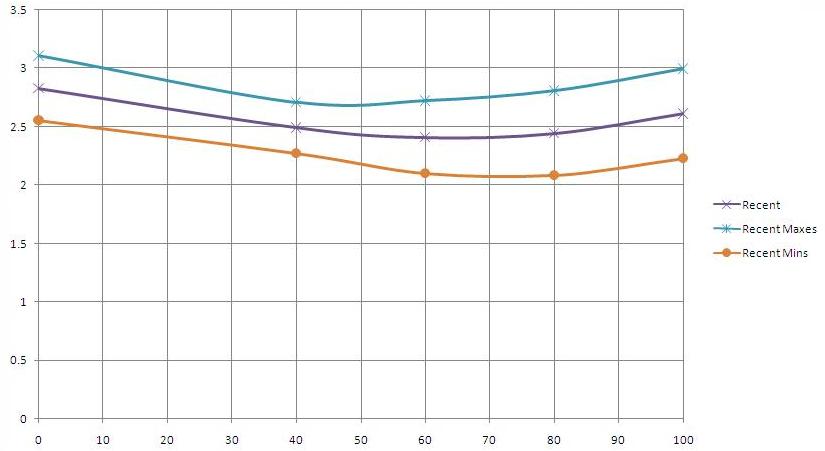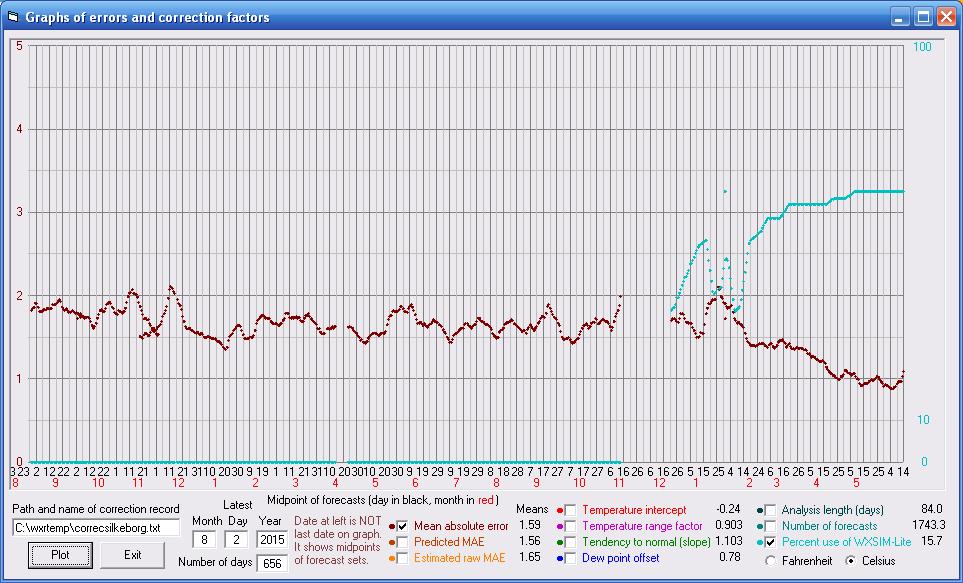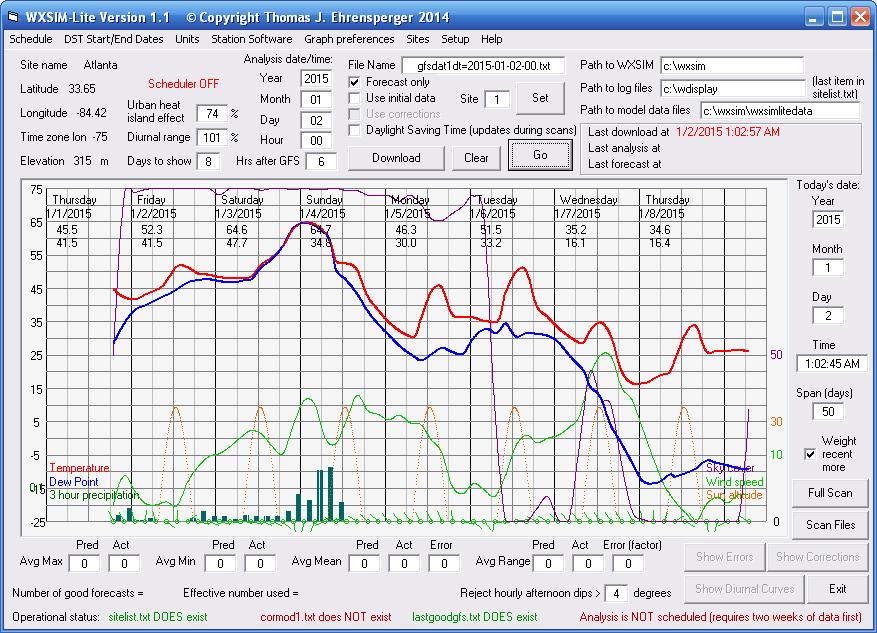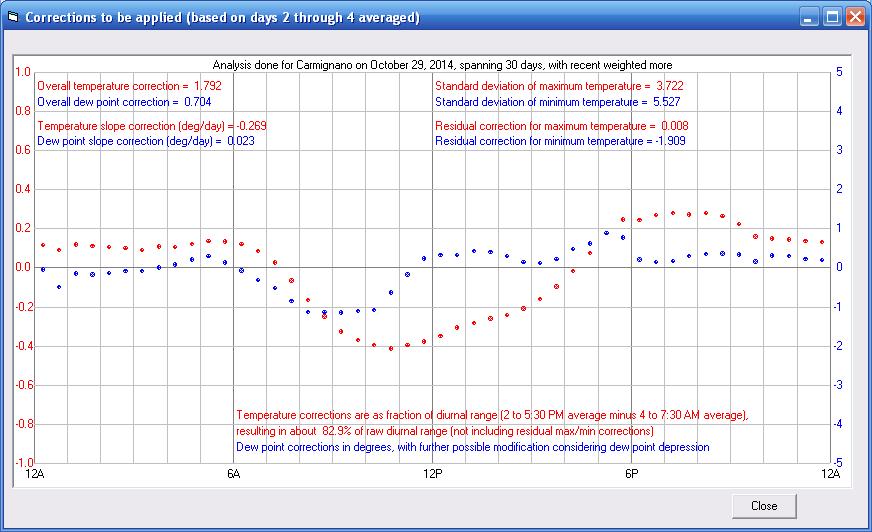WXSIM-Lite
WXSIM-Lite (the official name of wxsimlite.exe) was inspired by two main things: (1) the success of Autolearn-WX in reducing bias and improving WXSIM forecasts, and (2) the frustrating barriers to further improvement once systematic errors had been greatly reduced. Government and commercial forecast products have been improving over the years, especially in increasing geographical specificity, temporal resolution, and range of forecast details - all of these formerly relative strengths of WXSIM. For many users, some of these other products were doing better than WXSIM, after all the effort I'd put into it!
I decided to try another approach: instead of trying to do sophistcated internal modeling, I could use an approach similar to autolearn's to make site-specific bias corrections to raw model data from GFS (and perhaps other models in the future). This is not an original idea, as various tools, such as Model Output Statistics (MOS) have been applied to raw model data for decades. However, these efforts are usually specific to selected, official reporting stations. Applying bias-correction techniques to data from individuals' personal weather station data has the potential to provide these benefits to anyone with such a station, regardless of whether any official sites are nearby (or are even similar).
I started testing such a system in late 2013, on over a dozen sites (in most cases using data from customers) and continued through much of 2014. The bias correction techniques overlap with those in autolearn.exe, but also include corrections specific to each half-hour of the day. More details on this appear in the Help section of WXSIM-Lite, but briefly, among the many things accounted for are the exact minute of sunrise, the degree of urbanization of the site, and the amount of short-term variablity (minute-by-minute) in the site's temperatures.
The results were very encouraging, showing a very large improvement over the raw GFS model data, and even a significant improvement, of 5 to occasionally as much as 30% over WXSIM's forecasts. Now a new question arose: if these forecasts are better than WXSIM's, should this new program replace WXSIM?
WXSIM has an absolutely enormous number of features, most of which most users never scratch the surface of. It not only forecasts the standard meteorological fare, but also provides a wealth of very specific weather data, detailed soil and agricultural modeling, and even the ability to model the temperature effects of solar eclipses. It also is a great educational tool, in its interactive, simulation mode of use. It's too much, and too good, to leave behind.
Fortunately, I soon found a solution. WXSIM could 'listen' to WXSIM-Lite's forecasts of temperature and dew point, and take them into account, via a file written by the latter and read by the former. WXSIM could then still provide all its existing products, but with improved accuracy. Furthermore, I did statistical studies of the output from the two programs and found that they are only partially correlated, which means WXSIM has a somewhat individual 'opinion', rather than just being a degraded version of the same source information. This independence means that, even if WXSIM's forecasts are slightly less accurate, they still can add value to WXSIM-Lite's, if mixed together, with perhaps more weight given to WXSIM-Lite's data.
I've found that, indeed, such a mixture can produce results superior to either alone, especially in the case of nighttime temperatures, where WXSIM seems to have a somewhat 'original' opinion. In October, 2014, I began testing parallel runs at 0, 50, 80, and 100% WXSIM-Lite weighting, then in January, 2015 branched this into five runs (0, 40, 60, 80, and 100%). The mean absolute errors (in Fahrenheit degrees) for daily maximum, minimum, and mean temperatures, days 2 through 4 combined, for the January, 2015 through January, 2017 runs - representing 2306 time and data matched forecasts using each percentage - are shown below, plotting against percent WXSIM-Lite mixed in:

I will continue to research the ideal weight to use, but right now, anything from 50 to 75% appears to be nearly ideal, with improvement in my case of at least 10% over either WXSIM or WXSIM-Lite alone. I have some evidence that less well-customized sites may benefit most from a slight higher mix, of about 70%.
Both autolearn.exe and wxsimlite.exe take some time to become effective, because a sufficiently large base of past forecasts must be collected to 'learn' from. This takes at least a month, and doesn't reach full effect for two or even three months. Once they reach this point, though, they automatically continue to fine-tune the forecasts, taking into account seasonal and other gradual changes. Typically, either program alone should produce at least a few percent improvement in WXSIM's forecasts, and together, they can improve them even more. My current guess is that, for a well-customized site, wxsimlite.exe will produce a more dramatic improvement, while autolearn.exe may be most helpful for sites for which I had difficulty in getting the original customization right.
Here is an example (the best of several I looked at) made using autolearn.exe, of how WXSIM-Lite gradually improved forecast accuracy for a user in Denmark. Mean absolute error (here in Celsius degrees) had been hovering around 1.7 degrees for about 18 months, and then dropped to abuot 1 degree within a couple of months as WXSIM-Lite came got a larger learning base and as the data set contained more and more of these forecasts with WXSIM-Lite mixed in at 65%.

My intention is to continue to develop and improve WXSIM-Lite, thereby also improving WXSIM. This involves providing the specially prepared data for each user's location. The raw data for this is free (courtesy of U.S. taxpayers), but there is a modest cost for the server usage and we (Sam Bohler and I) need some compensation for the time and effort spent developing this (and incentive to continue to do so). I think this more naturally fits a subscription model, rather than an up-front cost and/or upgrade charges.
So, my plan is to make the WXSIM-Lite software and upgrades to it free of charge, and also to provide the data free of charge long enough to establish the system's value. I plan to implement a low-cost subscription system, at no more than $5 per month, at some point in the fairly near future. I promise to keep the rates low! Thanks for understanding the reasons for this.
By the way, all the data for WXSIM itself (downloaded thorugh WXSIMATE) will remain free of charge, as will upgrades to all WXSIM programs, for the foreseeable future.
Here is a view of WXSIM-Lite's main form, showing a forecast:

Here is a view of bias correction factors WXSIM-Lite determined for a site in Italy. Notice that the corrections for temperature and dew point are specific to the time of day, thereby taking into account very local, station-specific diurnal patterns:
